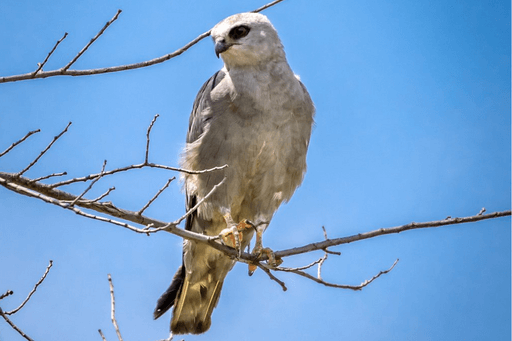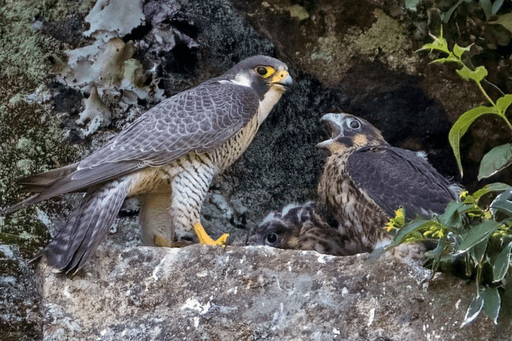Birds of Virginia: Raptors
Virginia hosts a diversity of raptor species, and there are hawk-watching opportunities at coastal and mountain sites during migration, which are usually most active in autumn. As raptor populations expand, some species are becoming more common in our urban areas, including the Cooper's Hawk, Mississippi Kite, and Peregrine Falcon.
Day-flying raptors and waterfowl are two groups with steadily recovering populations in North America. According to research published by ABC and other partners in 2019, populations of hawks and eagles in the U.S. and Canada increased by 78 percent (15 million birds), and Osprey populations quadrupled, since 1970.
Read on to learn about Virginia raptors to watch for, and keep your eyes on the skies, as any of these species might soar overhead when you least expect it.
This post is part of a five-part series in which we look at some of our favorite bird groups in Virginia (backyard birds, grassland birds, waterbirds, and forest birds) by profiling some of the most captivating species in each.
Bald Eagle

One of Virginia's largest bird species and the U.S. national bird, the Bald Eagle can be seen soaring overhead almost anywhere in the state. It is a majestic species that varies in coloration, since it takes several years to mature and achieve the iconic white head/white tail adult plumage. Like the more abundant Osprey, the Bald Eagle mainly eats fish, although it will also readily scavenge roadkill and steal food from other birds.
Location: Bald Eagles can be found year-round in much of Virginia, but are most common near water along major rivers, the Chesapeake Bay, and coasts. Resident eagles in the Chesapeake Bay are augmented by northern migrants in winter, and by individuals from as far as Florida in the summer. A few spots where Bald Eagles are regularly seen include Chincoteague National Wildlife Refuge on the coast, and several Northern Virginia nesting sites, including Riverbend Park in Fairfax County, Dyke Marsh Wildlife Preserve in Alexandria, and Occoquan Bay National Wildlife Refuge in Woodbridge.
Conservation: Populations of the Bald Eagle, Osprey, Peregrine Falcon, and Brown Pelican plummeted due to exposure to the pesticide DDT, until the chemical compound was banned in 1972. Since then, these species have experienced population growth and recovery thanks to conservation efforts and (for three of them) prior listing under the U.S. Endangered Species Act. Bald Eagle populations in the lower 48 states reached a low of 417 nesting pairs in 1963, but grew to 71,400 nesting pairs (and 316,700 individuals) by 2020, according to a report published by the U.S. Fish & Wildlife Service; of these, 1,500 to 2,000 pairs nest in Virginia. ABC has been a strong advocate for the Endangered Species Act (see this 2016 publication to learn more) and is active in addressing poisoning of birds by pesticides and other toxins.
Golden Eagle

Although widespread in much of the West, Golden Eagles are relatively scarce in eastern North America. The eastern Golden Eagle population was estimated to be about 5,000 birds in 2015, compared with tens of thousands in the West. Virginia is one of the core wintering states for the eastern population.
Locations: Golden Eagles are not easy to find in Virginia, but could turn up almost anywhere. In the winter they are most frequently spotted in the mountains, where hawk-watchers regularly record this species when conditions are best: north winds in early November. The Bluegrass Valley of Highland County (Hardscrabble Road is a good bet) is a regular wintering area for these majestic and very large birds. In addition, Burke's Garden, a beautiful valley surrounded by a ring of mountains, is home to a small group of Golden Eagles, Bald Eagles, and the occasional Rough-legged Hawk from fall through spring. Many regional birders make the drive into this remote valley in February to watch Golden Eagles soaring along the valley's high ridges, and to visit Mattie's Place, an Amish general store, for a hot sandwich and a donut.
Conservation: According to the Eastern Golden Eagle Working Group, eastern populations increased from the 1970s through the 1990s, but have not been increasing since about 2000. Lead poisoning and collisions with wind turbines continue to threaten Golden Eagles throughout their range. ABC has advocated for cautious siting of wind turbines and other practices to reduce the risk of collisions, as well as policies to reduce the risk of lead poisoning, such as promoting non-lead ammunition for big-game hunters.
Mississippi Kite

Mississippi Kites are long-distance migrants. They are present in our region late spring to summer, then depart for wintering grounds in South America (mainly southern Brazil, Paraguay, and northern Argentina). For decades, this species has been expanding northward as a breeder, even colonizing urban areas. Mississippi Kites are relatively new breeders in Virginia. The state's second Breeding Bird Atlas (2016-2020) confirmed nesting at more than two dozen sites. Mississippi Kites predominantly hunt medium to large insects in flight, including cicadas and dragonflies.
Locations: The second Virginia Breeding Bird Atlas eBird portal shows most observations of this species along the I-95 corridor from the North Carolina border to Richmond, and in Northern Virginia suburbs of Washington, D.C. In 2016, the westernmost record for Virginia-breeding Mississippi Kites was confirmed outside South Boston in the central Piedmont.
Conservation: The global Mississippi Kite population increased 25 percent from 1970 to 2014. ABC is active in sustaining and managing healthy forests as a partner in the Lower Mississippi Valley Joint Venture, through a partnership with the Sustainable Forestry Initiative, and with partners such as International Paper throughout the Southeast. Mississippi Kites and their close relatives, Swallow-tailed Kites, thrive in such managed forest landscapes, where a mosaic of forest conditions provides for nesting, roosting, and foraging. ABC works with corporate and family forest owners to incorporate Bird Friendly Forest practices, including maintaining large-tree stands that kites need for nesting, alongside harvest areas, where the birds frequently forage.
Peregrine Falcon

The Peregrine Falcon is one of the fastest birds in the world, capable of reaching speeds of more than 180 miles per hour while diving to nab other birds, including pigeons, ducks, and shorebirds. The species has a global distribution, occurring on all continents except Antarctica.
Locations: The Peregrine Falcon's return to historic mountain breeding areas continues at Shenandoah National Park, where 151 young falcons were released between 2000 and 2018, according to the National Park Service. Breaks Interstate Park in Dickenson County is one of five natural cliff sites in Virginia with falcon pairs. There, visitors can enjoy great viewing opportunities at easily accessible overlooks atop a scenic river gorge. In the Piedmont, a nesting pair in Reston Town Center is easily viewed from street level, as is a pair nesting in downtown Richmond, viewable remotely via the Richmond Falcon Cam. Kiptopeke Hawk Watch and Chincoteague National Wildlife Refuge are coastal sites where birders watch for Peregrine Falcons.
For video of four downy chicks being banded in June 2021 near their nest on the 21st floor of the Riverfront Plaza Building in Richmond, see this link.
Conservation: Like the Bald Eagle, the Peregrine Falcon is a conservation success story in North America. Populations have grown substantially since being decimated by DDT exposure, thanks to the banning of this pesticide, prior protection under the U.S. Endangered Species Act, and active reintroduction and translocation programs to restore the species to areas from which it had vanished. These reintroduction programs were led by the Peregrine Fund and U.S. Fish & Wildlife Service along with many local partners. Although the Virginia Peregrine population historically nested on natural cliff faces, many pairs currently nest on artificial structures, such as bridges, smokestacks, and tall buildings in urban areas. The Virginia population is currently 29 pairs.
We hope you enjoyed this blog post about Virginia raptors. We recommend the following as additional resources for bird-watching information specific to Virginia:
- Virginia Bird & Wildlife Trail, an organized network of outdoor sites highlighting the best places to see birds and wildlife in the commonwealth.
- Second Virginia Breeding Bird Atlas (eBird Portal) ebird.org/atlasva/home (Note: A free eBird account is required to view these maps/data.)
- Virginia Society of Ornithology www.virginiabirds.org.
- Northern Virginia Bird Club www.nvabc.org.
- Birding Virginia for birding site information with profiles on birding hotspots and counties.
- A Birder's Guide to Virginia, by David W. Johnston, 1999, American Birding Association.
Authors
Daniel Lebbin, Vice President of Threatened Species, American Bird Conservancy; Sergio Harding, Nongame Bird Conservation Biologist, Virginia Department of Wildlife Resources; Ashley Peele, Avian Ecologist, Conservation Management Institute, Department of Fisheries and Wildlife Conservation, Virginia Tech; Becky Keller, Science Coordinator, Appalachian Mountains Joint Venture, American Bird Conservancy; EJ Williams, Vice President, Southeast Region, American Bird Conservancy
Thanks also to Lindsey Troutman, Craig Watson, Ruth Boettcher, Kirsten Luke, Jeff Larkin, Jen Davis, Andrés Anchondo, Peter Dieser, David Wiedenfeld, George Wallace, and the Appalachian Mountains Joint Venture Team (Elizabeth Brewer, Amanda Duren, and Jessica Wise) for their suggestions and edits to this blog series.


















































